Familiar as our objects and rituals of daily life are to us, to someone from the 16th century they would appear most, most, odd, just as their familiar 16th century objects and rituals would appear most, most, odd to someone from the 11th century: yet as Simon & Garfunkel teach us "that's not unusual, No, it isn't strange", for as societies develop they acquire new objects and rituals, daily life continually evolves anew alongside, and in conjunction with, new objects and new rituals. And if we were to be acquainted today with objects and rituals from future societies we would consider them most, most, odd.
With the exhibition New Normals at Haus am Waldsee, Berlin, Konstantin Grcic presents some exceedingly odd things and in doing so invites us all to reflect on the fact that that which is not yet, will one day be.......
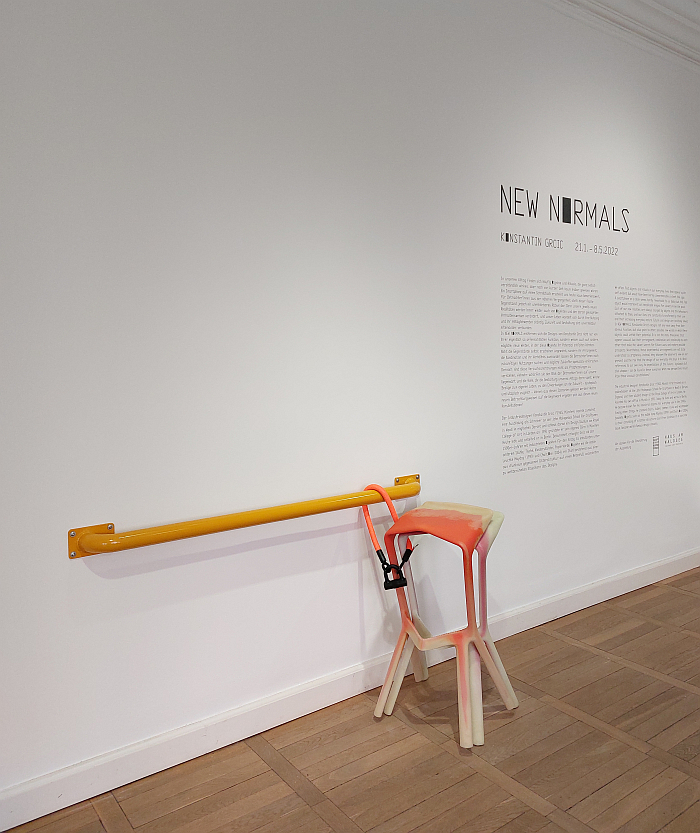
New normal is, yes, very much a term associated with the Covid pandemic; however, as Konstantin Grcic is keen to underscore, New Normals is not a Covid pandemic exhibition, is an exhibition whose development began in the pandemic but at a time when all assumed that by January 2022 the pandemic would be behind us, would be an ex-normal, and is thus an exhibition which has its origins less in the new normal of the face mask or the later flow test as in more general objects and rituals which initially appeared strange, alien, but quickly established themselves as thoroughly normal, Grcic naming examples such as urban surveillance cameras or smartphones. And a phenomenon of the new normal, of the alien becoming familiar, of the novel becoming a taken-for-granted obviousness Konstantin Grcic wanted to explore in more detail, using his own designs as the conduit, primarily his own furniture designs.
The result is a presentation in which some 20 of Grcic's designs have undergone a transformation, an alienation, sometimes through additions, sometimes through abstractions, sometimes through new associations, sometimes through new contexts and thereby become suggestive of something else, pose questions that in their previous normal normal they don't allow one to formulate and in which a future normal normal no-one would be able to formulate; questions which help one approach an appreciation of the movement from current normal to new normal without demonstrating that movement, without anticipating the direction of that movement, without knowing the nature of that movement, without.......
.......yes, you're right, an example or two probably would be helpful.

According to Konstantin Grcic one of the earliest images he had in the development of New Normals was that of his Vitra Stool-Tool with antenna attached to it, an image that greets you in the Haus am Waldsee conservatory.
Why does a Stool-Tool have antenna attached to it? A very good question, as is why does a Stool-Tool need antenna? What do antenna enable a Stool-Tool to do? What do antenna enable us to do with a Stool-Tool? How do the antenna and that which they enable and embody change the way one uses a Stool-Tool? How do the antenna alter our relationship with a Stool-Tool? Is a Stool-Tool with antenna still a Stool-Tool?
Konstantin Grcic doesn't give you any answers, doesn't even suggest possible answers, there may in fact be no answers. Nor does Konstantin Grcic pose any questions that may lead to possible answers; the formulation of the questions, and the subsequent questioning of the questions in search of possible answers is very much left to the visitor, each being left, empowered, to engage with the proposals in their own way and to follow their own chains of thought.
Thoughts such as, a Stool-Tool with antennae reminds one very much of K9, Dr Who's faithful robotic dog. The robotic dog being very much a potential new normal, albeit whereas K9 looks like a Stool-Tool with antenna, potential new normal robotic dogs will look like dogs.
Thoughts which remind us all, and as we all remember from the exhibition Back to Future. Technology visions between fiction and reality at the Museum für Kommunikation Frankfurt, those things that become new normal normals often arise from a cultural influence and/or are manifestations of ideas that have been bobbing around for a while, and that they rarely take on the form in which they were first proposed.

Spread over the two floors of Haus am Waldsee, a location that very much is a house on the shores of the Waldsee in the south east of Berlin, New Normals features both propositions that offer relatively direct points of access and those that require a lot more effort on the part of the viewer to gain access.
The former being perhaps best exemplified by a Traffic lounger for Magis to which an array of smartphone and tablet holders have been attached via aluminium rods; a composition which one has to assume that if Anton Lorenz were still amongst us he would have developed a long, long time ago as an actual further development of his chunky TV recliners, and which by now would have become a normal normal in the homes of suburban America. Or by a Vitra Allstar office chair attached to scaffolding poles by three elasticated gymnastics bands which allow it to be pushed and pulled in all directions, and which aside from very simple allusions to contemporary agile working, and the unquestioning flexibility demanded of employees by many contemporary employers, also allows for reflections on, for example, the ergonomics of office furniture, of ergonomics as being less something embedded in the object as in the nature by which an object is used; having to physically act in order to stop your chair racing off in an unwanted direction, or having to physically urge your chair to roll to the filing cabinet sounding like good ways of activating muscles and joints that sitting traditionally harms. And while yes a chair fixed at three points by elasticated gymnastics bands to scaffolding poles does look odd, it doesn't look any odder than the thoroughly ungainly base of Thomas E. Warren's late-19th century Centripetal Spring Chair, and who today would say no to an elegantly formed office chair that moves responsively in 360 degrees? What new form of office chair, what new office seating concept beyond the office chair, does Grcic's Allstar/elasticated gymnastics bands composition offer? Is the key to Grcic's Allstar/elasticated gymnastics band composition the chair or the bands?
Not that the New Normals propositions should be confused with concrete propositions, they may be called Normals in the exhibition, but they are very much Odds; much more the New Normals propositions represent an abstract questioning from which nothing may arise other than the various and varied questions of the varied and various viewers.
Something more apparent and appreciable in the, for us, less directly accessible propositions.
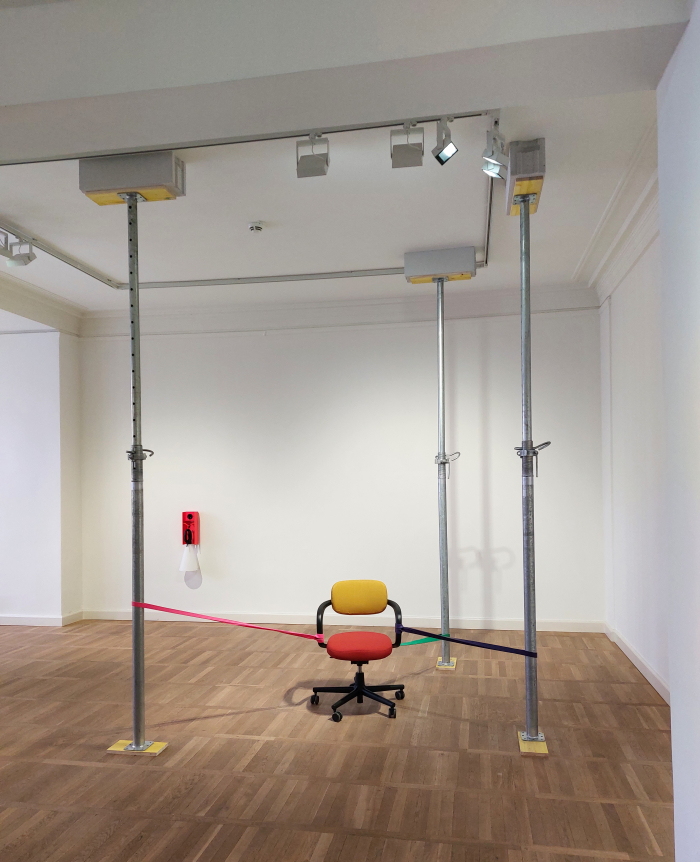
Those, for us, less directly accessible propositions which, arguably, compose the greater part of New Normals, which isn't a criticism, far from it, modern life involves far too little independent thought, we're all for forcing a little bit more.
Forcing you to consider, for example, why a Medici lounge chair for Mattiazzi is behind the windscreen of a Citroën DS4? ... ? ... Because in the new normal communication and entertainment devices will descend from the ceiling at an ideal distance from us. Powered by telepathy ... ?
¿Why are examples of Grcic's seating design, including a MINGX for Driade, secured to the walls and floors with bike locks? ... ? ... Because in the new normal cultural inspiration has become formally equated with cultural appropriation and thus banned, thereby locking solutions in a particular culture and context and consequently denying the cultural exchange that is so important in the development of communities and objects and rituals of daily use ... ?
¿Why are two Myto chairs for Plank suspended upside down on pantographs? ... ? ... Because............ ... ?
¿Why have two Brut sofas for Magis been drawn together with a security net above them?
Because two is us, and Brut + us = Brutus, and is a domestic sofa not a Forum much like those of ancient Rome? Similarly the visual image cast by the two Bruti very much reminds one of Masanori Umeda's Tawaraya boxing ring bed/sofa for Memphis, drop the net over the Bruti and you have a cage fighting arena, a new normal that is far, far, far, removed from the senseless savagery in the name of entertainment, fame and financial gain of the Roman Arena; and an alternative take on the domestic sofa as an Arena, as a Forum, as a location of not just tussling and fighting and argument and discourse, but one of joy, of despair, of laughter, of distress, of friendship, of success, of tears, of lions, of bonding, of plotting, of failure, of learning, of compromise, of beginnings, of endings, of emotion, of belonging, the domestic sofa as the centre of a family's social and political existence. And if a domestic sofa is a new Roman Forum, a new Roman Arena, what demands does that place on the design of a sofa? How can a sofa be designed to enable it to combine the Roman Forum and Roman Arena in a contemporary space?
Which is just one of the chains of thought the Bruti elicited in us, and is by no means definitive. Or necessarily rational.
And one of many chains of thought elicited by the propositions that help remind us all that while any given piece of furniture is a definable physical object, it is also a lot, lot, more.

And thereby New Normals helps remind us that we rarely live with a piece of furniture as the designer envisaged it, much more the function of a furniture object develops through use and over time, any given object fitting into the life of the user, while the user adapts to the options presented by that object; the object becoming its own normal normal in a specific context and independent of other normal normals. A reality we discussed from The Ulmer Hocker: Idea ─ Icon ─ Idol at the HfG-Archiv, Ulm, noting that the HfG-Archiv have identified 12, sadly unstated, alternative uses at the HfG Ulm for that most simplest of sitting objects beyond simply sitting on it, a tradition carried on to this day and as exemplified by the Was? Wie? Wo? Open Call the HfG-Archiv initiated.
Konstantin Grcic speaks of such as hacking, and New Normals can be considered extreme hacking, extreme speculative open-ended question hacking; hacking not in the sense of Jugaad or Gambiarra with a specified goal, but in the sense of looking to see where it takes us, and where it may subsequently enable us to go on from there. An extreme speculative open-ended question hacking that necessitates a teleological suspension of the rational. An extreme speculative open-ended question hacking sited very much at the macro scale of society rather than the micro of the individual, but which assumes a comparability, assumes there is an exchange.
And a hacking that for all it allows access to considerations on new normals, on the fact that our objects and rituals of daily life are in continual processes of evolution and development, produces propositions that in and of themselves don't, can't, elucidate how the strange, the alien, establishes itself as thoroughly normal in wider society. Yet while not directly approached in New Normals that how is very much present in your thoughts as you attempt to engage with the various propositions: how, you ask yourself, does the new global normal occur? Who decides?

As European society moved from the 11th century to the 16th objects of daily use, normal normals, were largely the preserve and right of a very limited sphere of society, chairs, for example, and to remain in the primary context of New Normals, barely existed in the 11th century but by the 16th century the back-stool was making ever more rapid headway. Or at least was amongst that very limited sphere of society with access to domestic seating objects. And because objects of daily use only existed for a very limited sphere of society their development was driven by and exclusively focussed on that limited sphere, the needs, requirements, opinions of the vast majority were a thorough irrelevance.
As European society moved from the 16th century to the 21st century not only the did the back-stool increasingly cede to the side chair, but objects of daily use, normal normals, both increasingly became for ever wider sectors of society, and, and importantly, the decisions as to their form and function and necessity increasingly began to take into account wider needs and positions. Albeit, while an ever increasing portion of society was brought into, considered and involved in the decision making processes, it was and is largely a process undertaken in context of institutional and/or commercial processes, "Who decides, [what furniture is available]", asked Verner Panton in 1995, "the customer, the man on the street, the furniture dealer, the designer or the manufacturer?"1
Who decides today?
Who will decide, and who should decide, as we move towards the 26th century, assuming that is we make it that far, who will decide not only what furniture is available but what becomes normal normals in our new (European) society? And as anyone over the age 35 knows only too well, that new society, and those new normal normals, are already on their way.
Are already amongst us.
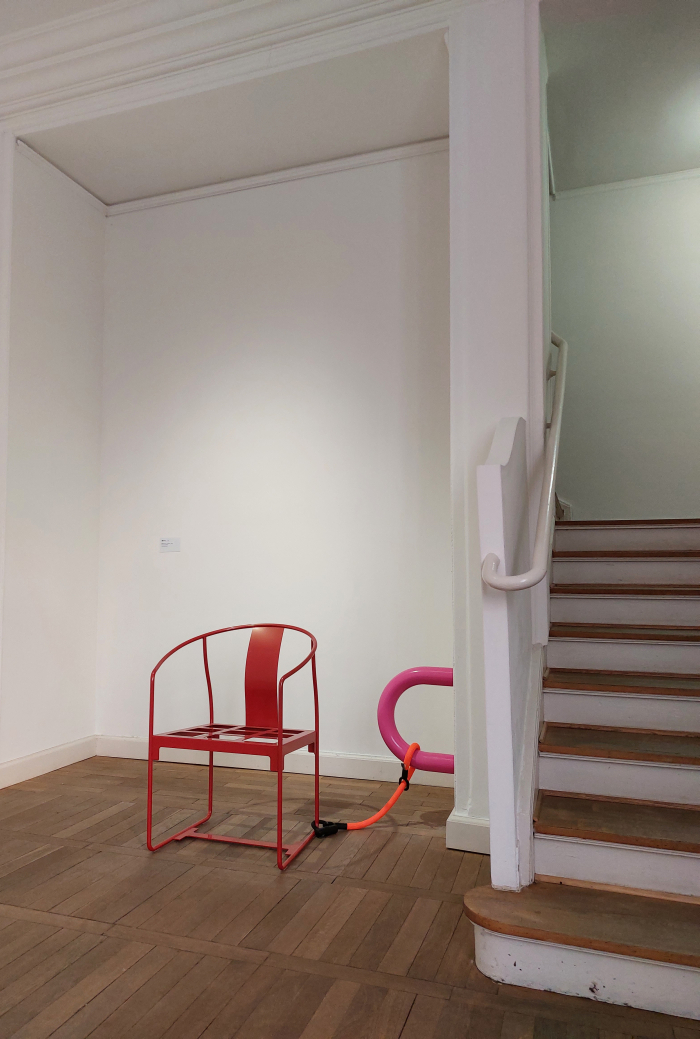
As noted above much of what becomes a new normal normal has often undergone a long journey, has often been bobbing around in the undercurrent for an eternity before rising to the surface, a rise that on the one hand often requires the development of new materials and new technologies, the aforementioned smartphone being a particularly good example of something that was envisaged and defined long before it could physically exist. On the other hand social and cultural changes can bring forth a new normal normal; oat milk was once harder to come by than unicorn milk, but owing to increasing understandings, and acceptance, of the relationships between our behaviour and the health of our plant, is now ubiquitous.2 Or the jumble of the QR code, a concept which to all intents and purposes was dead and buried, had fought spiritedly over the years but failed to become the normal normal it aspired to. Then came the Covid pandemic and it is now impossible to image a day without engaging, on several occasions, with a QR code. And going forward its easily conceivable that the QR code will remain a normal normal.
And on the rare, and thus all the more valuable, third hand, conditioning, inarguably, plays an important role. The rise of the urban surveillance cameras Grcic refers to required the acceptance of a political argument that while they meant the state monitoring individuals they were necessary for improving security, an argument whose acceptance, and to paraphrase Friedrich von Borries' argument in Politics of Design. Design of Politics at Die Neue Sammlung Munich, can be understood as a progression from the development of baby monitors in the 1930s to allow parents to keep an eye on their sleeping brood, a popular acceptance of monitoring in the name of security at a private, personal level as the start of a soft path to the popular acceptance of wider, communal, surveillance3. A path whose continuation can be understood in the contemporary rise, the new normal, of video doorbells filming our streets 24/7, filming us all as we walk along our streets 24/7, a development that tends to indicate that not only the surveillance camera itself has become an accepted normal normal, but the necessity of constantly monitoring the movement of those with whom we share our towns and cities, a core position of mistrust of those with whom we share our towns and cities, as a fundamental component of making our towns and cities safer places has also become a normal normal. With all the as yet unknown consequences that has going forward.
Reflections on conditioning, and soft paths, that tend to an argument that ideas need to reach a critical mass of popular acceptance in order to become a normal normal, and which arguably has always been so throughout the centuries, the differences throughout the centuries, arguably, being found in who and whom were involved in the process, in whose and whoms opinions were asked and whose and whoms needs considered: and in comparison to the (European) societies of the 11th, 14th, 16th or 19th centuries we are all not only better placed today to appreciate that we all, individually and collectively, have a valid voice in what becomes a normal normal, but that we have a lot more influence, individually and collectively, in the defining of new normal normals. The (soft) paths we're on aren't to pre-defined destinations; rather we all, individually and collectively, have an influence on the route.
The important question is how do, should and will we exercise that influence? Via the who can shout loudest of social media or through actual discourse?
And while furniture, questions of how the spaces we inhabit and how the objects with which we share those spaces should develop into the future, is a good place to start, is a good place to establish inclusive decision making processes, we'd argue that autonomous vehicles and delivery drones, and for all their nefarious offspring flying taxis, are the much more acute and urgent discussions. And smart robotic dogs.
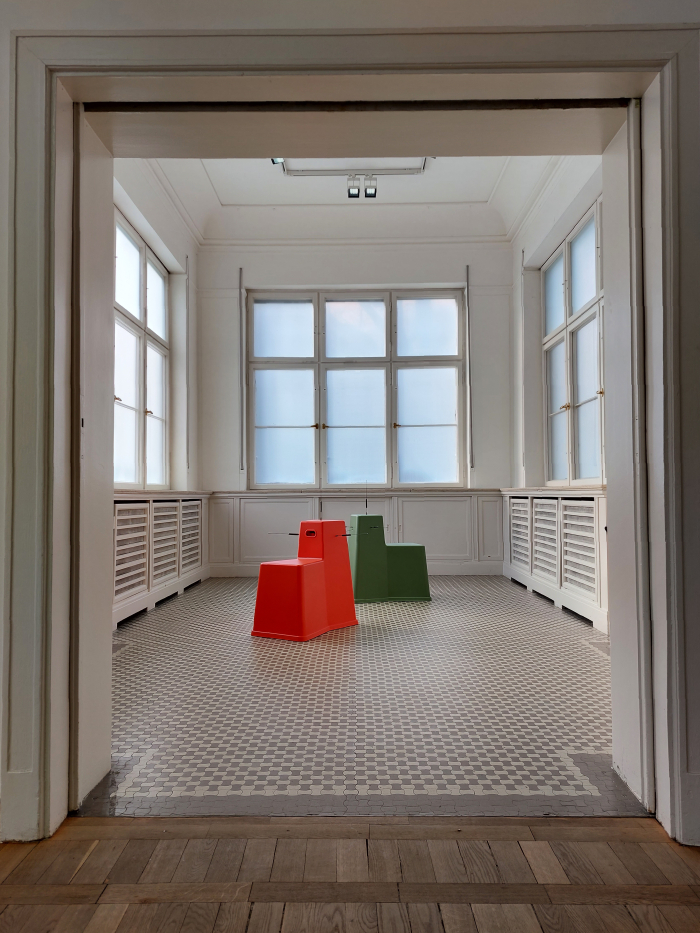
Although not an exhibition of Konstantin Grcic's work, as an exhibition populated by Konstantin Grcic's work New Normals is also a good opportunity to refamiliarise yourself with popularly known Grcic works through the new forms, contexts, functions et al in which they find themselves, to study the ways and means of Grcic anew; and, and very pleasingly, a good opportunity to become acquainted with lesser known Grcic works such as the Table Chair prototype that was shown by Vitra at Orgatec 2016 but which has been relatively quite since, or the Banzai table from the Champions collection for Galerie Kreo which is generally only seen in context of (exclusive) design fairs.
And also a good opportunity to become acquainted with unknown Grcic works such as the plastic stool Chap for Vitra: a plastic stool that without question owes its genesis to the industrial metal and wood Werkstatthocker, workshop stool, of the 19th and 20th centuries and thus an object arsing from that nurturing of the existing the Historia Supellexalis places at the core of Grcic; a plastic stool that features a removable storage unit in its base and which thus represents the added function to an existing object that enables new interpretations and relationships and modes of use that can be found in many of the New Normals propositions; a plastic stool which can also be a plastic side table, a plastic atelier assistant, a plastic home office organisation aid, a plastic bathroom cupboard, a plastic whatever and thus a plastic stool very much in the tradition of the Ulmer Hocker; a plastic stool listed as being from 2021, but which wasn't, which, one assumes on account of the pandemic, is still awaiting a formal launch. And a plastic stool which, and at the risk of confusing commerce with culture, is a work that once Vitra do release it could very quickly become a new normal normal.
As indeed could something not on show, but very present in New Normals: every proposition is accompanied by a Mayday lamp for Flos hanging from a bright red/orange plug box, and while the cable is very present, the bright red/orange plug box's resemblance to a charging station very neatly amplifies the oft posed question of why not a rechargeable, cable-less Mayday? A question we ask ourselves twice a year when we vacuum the smow Blog flat and have to move the cable out the way. And while, yes, we gladly and freely accept that when it was first designed the cable was an important part of the concept, is part of that which defined Mayday, in the years since long cables have vanished from the sort of lamps which inspired Mayday; that while Mayday may have been an early example of a domestic lamp that could be used mobily and freely in a space, was a herald of a new normal, in that new normal Mayday has something of the old normal about it, has something as olde worlde about it as paying in cash. If remaining an object we adore. And without which we'd sit in darkness all winter long. ¿But which could, should, lose its cable?
The ubiquity of Mayday throughout New Normals also being the most joyous metaphor; that every room, every scenario, screams MAYDAY!!! at you reminding of the dangers facing contemporary society, of the predicaments our planet finds itself in, and the responsibility we all have, individually and collectively, in facing those dangers and predicaments. Reminds you that the new normals that can be derived and developed and imagined from the propositions must be a component of facing those dangers and predicaments, must exist in context of abating and resolving those dangers and predicaments.
And which helps underscores that for all the superficial impression that New Normals is an art exhibition, New Normals is very much a design exhibition.
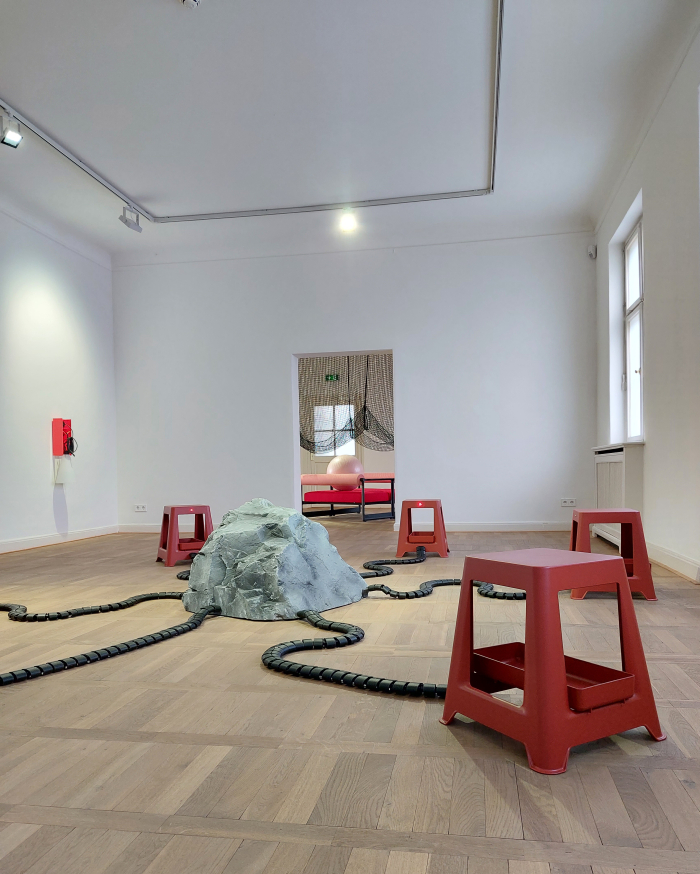
There is no single design process, and even if there were, each and every designer would by necessity develop their own definition of it; rather there are innumerable different paths to objects, and while some are directly, consciously, unwaveringly focussed on and geared towards the development of a specific object for a specific context, others are much more abstract and indirect, meander their way to their destination over several intermediary staging posts. For many years Konstantin Grcic has cooperated with the aforementioned Galerie Kreo, as have the likes of Ronan & Erwan Bouroullec or Pierre Charpin, and while the results of such a gallery cooperation can ultimately result in a commercial product, the cooperations are primarily about encouraging a meandering, about developing a space in which to reflect, to experiment, to test, to question, to sketch, to contradict, to grasp around in the darkness, away from the pressures of commercial considerations, away from commercial intentions, away from that which former Vitra CEO Rolf Fehlbaum once joyously called the "unmerciful censor of all ideas".4
New Normals is also such a space. And as such is a space that lacks any purpose other than that which arises from it. A space which takes no specific position, which can't be neatly defined. A space without baggage. A space which doesn't demand or judge and certainly doesn't censor. And thereby exists as a relatively neutral space which gives you the room and time to reflect on our objects of daily use, how we interact with our objects of daily use, how they influence and inform us and our daily rituals, the relationships between us our objects our rituals and wider society, and how those invariably change and evolve over time at both the micro and macro level, in how far our demands, individually and collectively, align with what manufacturers, designers, architects, Instagram et al tell us is desirable and meaningful.
A space which through being populated with works by Konstantin Grcic reminds us all that new normals are often concentrations of old normals in new forms, are often a reduction of function to a minimum of material; reminds that new normals needn't necessarily be based on new technology can be based on more intelligent, differentiated, nuanced uses of existing technology; reminds us that new normals needn't be new new can be new old adapted and evolved for contemporary realities, that we needn't continually reinvent the wheel but must continually reflect on how we construct wheels, how we employ wheels and question why wheels are relevant for contemporary society.
A space which through being populated with works by Konstantin Grcic reminds us all that while furniture should be functional and attractive, those are subjective terms, more important is that furniture is responsive, communicative, and doesn't take itself all too seriously, doesn't get caught up in inflated understandings of its importance.
But for all New Normals is a space in which to better appreciate that odd, strange, alien as a table sprouting mirrors or a Stool-Tool with antenna may appear in 2022, in the future they may be thoroughly normal. And to better appreciate that we all have a role in defining the normal normal a table sprouting mirrors or a Stool-Tool with antenna or our smartphones or our cities or our dogs or our taxis become. That we all have a role in defining the normal normal our societies become.
Konstantin Grcic. New Normals is scheduled to run at Haus am Waldsee, Argentinische Allee 30, 14163 Berlin until Sunday May 8th.
Further information can be found at https://hausamwaldsee.de
And as ever in these times, if you are planning visiting any exhibition please familiarise yourself in advance with the current ticketing, entry, safety, hygiene, cloakroom, etc rules and systems. And during your visit please stay safe, stay responsible, and above all, stay curious......

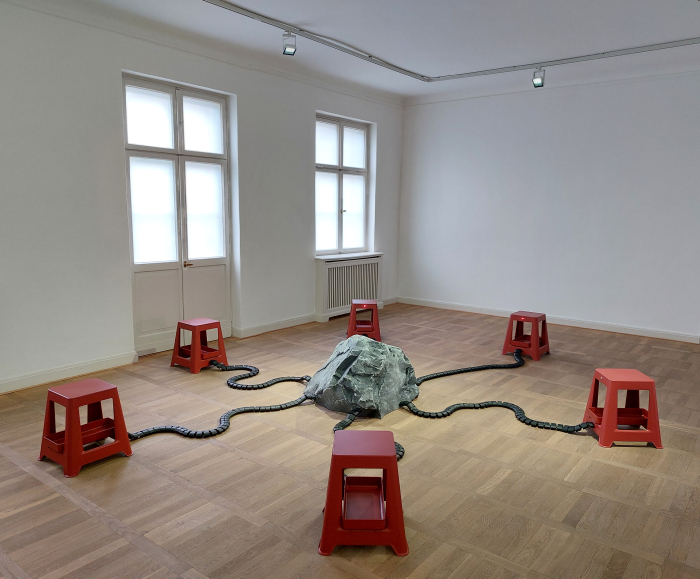
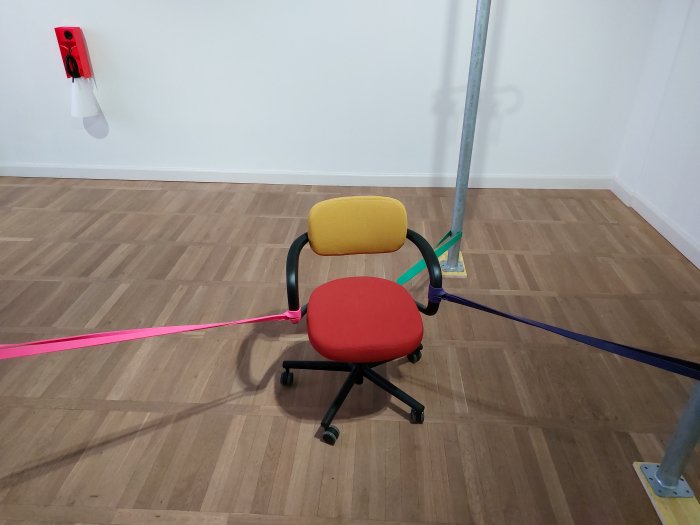

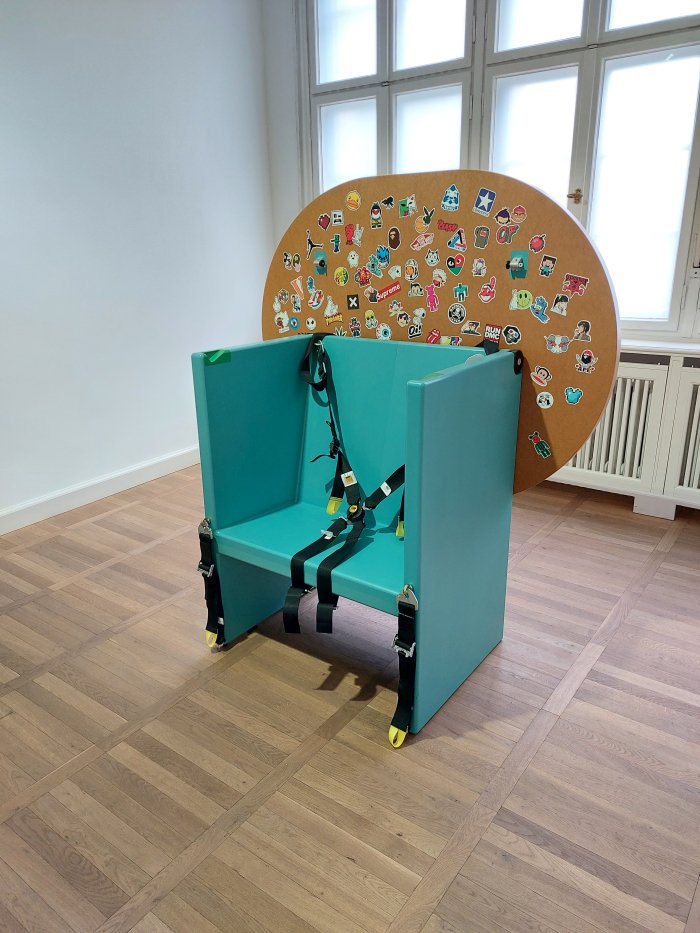
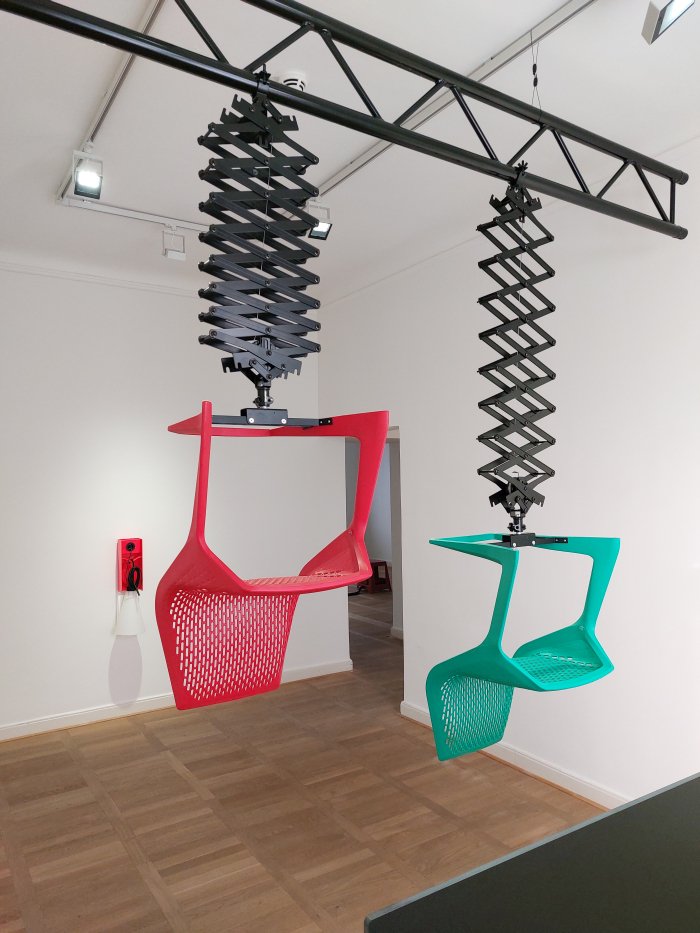



1Verner Panton: Meine Design-Philosophie, BÜROszene, Vol 47, Nrs. 1–2, 1995 Although first published in 1995, it is (based on) a speech Panton held several times in the 1980s.
2Oat milk may just be a lifestyle fad independent of environmental and health concerns and primarily driven by commercial interests and marketing...time will tell....
3Real design journalists would at this point start quoting Michel Foucault at great length, we won't, but feel free to delve in yourselves......
4Rolf Fehlbaum in Uta Brandes; Alexander von Vegesack [Ed], Citizen Office: Ideen und Notizen zu einer neuen Bürowelt, Steidl Verlag, Göttingen, 1994, page 8